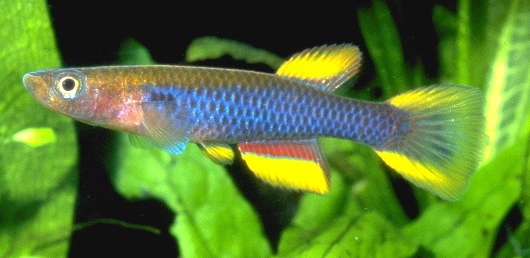

A.citrineipinnis
TBT 98 / 8
Photo courtesy of Peter Tirbak
| Meaning of Name |
After the general yellow colouration of the fins. | ||||||
| First Description |
Huber J.H & Radda A.C. 1977. Cyprinodontiden Studien in Gabun IV Das du Chaillu Massif. Aquaria 24 : 89-110. | ||||||
| Size |
4.5 cm ( Radda & Pürzl 1987). | ||||||
| Meristics |
D = 11-12, A = 15-16, D/A = +7-8, ll = 29-30 + 2-3. | ||||||
| Karyotype |
| ||||||
| Sub-Genus |
Mesoaphyosemion | ||||||
| Group |
A.coeleste | ||||||
| Synonyms |
None | ||||||
Populations
|
A.citreinipinnis Yéno, Gabon. Photo courtesy of Ed Pürzl. | ||||||
| Type Locality |
G21 / 76. A rapidly flowing mountain river near Yéno, Mogambi Ogoudou - Ougoulou. A drainage system of the Ngounie River drainage, southern Gabon. Width of this stream was 2 - 12 metres which was damned to provide a washing place near a road. Water depth was 10 - 60 cm. Measurements taken at 15.30 hrs were - air temperature 24°C, water temperature 20·5°C, DH ·5, pH 5·5. Sympatric sp. included A.joergenscheeli & catfish sp. Collected on the 9th August 1976. | ||||||
| Distribution |
The Du Chaillu Massif, to the north & west of Mimongo, in the Ngounié River system south, central Gabon. | ||||||
| Habitat |
The type locality is a rapidly flowing mountain river
2 - 12 metres wide. This river was damned to form a washing place. Water measurements
taken at 1530 hrs were water temperature 20·5°C, pH 5·5, DH
·5, water depth 10 - 60 cm.
| ||||||
| Distinguishing Characteristics | This sp. has no red markings in fins or body which seperates it from most Aphyosemion. Un-paired fins are lemon yellow with a light blue/purple colour can be seen on the body. It is reported that a faint dark spot may appear near the base of the pectoral fins when the fish are frightened. | ||||||
| Colour/Pattern Variability | Low | ||||||
| History |
| ||||||
| Breeding Notes | Reportedly hard to breed but also similar to an easier sp. A.ocellatum. Breeding follows the same pattern as A.ocellatum. The eggs should be water incubated & hatch in 2 - 3 weeks. Maturity comes slowly & 6 months will need to pass for the young to reach it. A natural breeding set up where the fry are allowed to grow on in the parents tank is thought to be better. It has been reported that they breed successfully at 16-18°C. Also it has been noted that they start to lay during bad weather or low barometric pressure. | ||||||
| Diameter of Egg | |||||||
| Remarks |
|